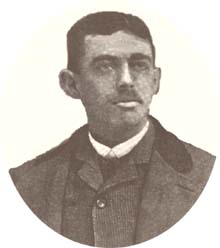Gunther and His Railroad by
Morton Morris
Page
2
 The author, in 1886. Paul Matus
Collection
The author, in 1886. Paul Matus
Collection
The Transportation
Problem
That was a problem that gave myself and my neighbors
of what is now Bath Beach, Ulmer Park and Coney island more food for
thought 35 years ago [from 1906] than it does today. Ulmer Park was then
called Guntherville; Bensonhurst was Locust Grove, and Benson Avenue and
Bay 18th Street was Wright's Corner station. other regular stops on, the
old Brooklyn, Bath and Coney Island Railroad, that ran between 25th Street
and Fifth Avenue to Coney Island, were: New Utrecht Avenue, now Van Pelt
Manor; The Gully, now 74th Street station; Kowenhoven's Lane, now
Homewood; Weir's Hill, now 62nd Street; and City Line, now called 39th
Street.
Those were the regular
stops.
Then there were many irregular
ones.
But first something about the owner
and president of the road.
The old Brooklyn,
Bath and Coney Island Railroad was the first ever run to Coney Island. it
was built by Charles L. Gunther.
Mr. Gunther
was born February 7, 1822. His parents were German, his father having been
Christian G. Gunther, and for about fifty years was the leading fur
merchant of New York.
He was educated at
Nazareth, Pa., and on returning to New York entered the Columbia Grammar
School. At an early age he was taken into the firm of C. C. Gunther &
Company, comprising his brothers and father.
He was interested in politics and became a member of the Young Men's
Committee and cast his vote for Polk and Dallas, in
1844.
He was one of the founders of the
Democratic Union Club.
In the spring of 1863
he was elected a sachem of Tammany Hall, having two years previous to that
time been nominated for mayor, but defeated.
In 1863 he ran again for mayor and was elected by a plurality of 7000. He
took his seat January 1, 1864.
After his
retirement from the mayoralty, he devoted himself entirely to his private
affairs and was one of the first to recognize the great possibilities of
Coney Island. He built the first steam railroad to the beach, thereby
incurring the enmity of the old Dutch farmers of Gravesend and New
Utrecht. He also built a hotel at Coney Island called the Tivoli, but it
never proved profitable. He also built another hotel at Locust Grove, now
about Cropsey Avenue and Bay 29th Street, but that was destroyed by
fire.
Later he went into politics again, and
ran for senator of the seventh district, but was defeated. He died January
22, 1885.
At the beginning of the operation
along what is now the West End Line of the Brooklyn Rapid Transit system,
horse cars were used. They were operated from 25th Street and Fifth
Avenue, along New Utrecht Avenue, then known as "the old plank road." At
first these cars made one trip in the morning and one in the
afternoon.
When the spirit of progress decided
to flap its wings over the situation, a small "dummy" engine was
purchased. The engine proper and passenger car were all one, with seats
for about forty people. The fare for the round trip from Coney Island to
25th Street was fifty cents, with an additional five cent fare if a
passenger wished to continue into the business district of Brooklyn. In
other words, the car fare for the round trip in those days from the
vicinity of Fulton Street and Myrtle Avenue to Coney Island was sixty
cents. The ferry charges were additional, of course, to get to New York
and back.
The arrival of a spick and span
"double ender" engine, called the "Modock," was celebrated with
considerable enthusiasm as a most determined step in the march of progress
in the transportation development.
By "double
ender" it was meant that this marvel possessed the alacrity of being able
to run either forwards or backwards. We soon di that this accomplishment
of the Modock's possessed a never-ending source of entertainment for the
patrons of the line.
Not even the engineer was
ever quite positive at any time, on starting out on a trip, which part of
the Modock would become animated first or which direction it would be most
likely to take.
Continued on page 3
Copyright © 1975 by Third Rail Press, © 1999 by The Composing Stack
Inc.
Reprinted by permission. Not responsible for
typographical errors.
The Third Rail and The Third Rail
logo are trademarks of The Composing Stack Inc.

 The author, in 1886. Paul Matus
Collection
The author, in 1886. Paul Matus
Collection